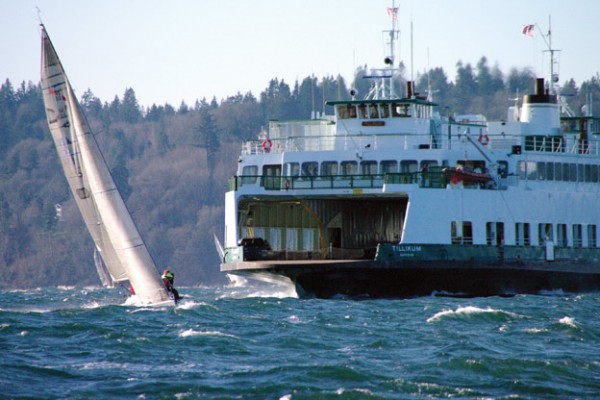Coexisting on the Sound with the Ferry System
 With an aging workforce and an aging fleet, our state’s ferry system isn’t without its challenges. Yet the voyage to solving those challenges isn’t optional; the very existence of that ferry system is an undeniable, irreversible imperative for the economic health of our entire region. Tangentially, they’re also a very attractive piece of the visual puzzle when one gazes out over the water. I can’t imagine a day boating on Puget Sound without spotting one.
With an aging workforce and an aging fleet, our state’s ferry system isn’t without its challenges. Yet the voyage to solving those challenges isn’t optional; the very existence of that ferry system is an undeniable, irreversible imperative for the economic health of our entire region. Tangentially, they’re also a very attractive piece of the visual puzzle when one gazes out over the water. I can’t imagine a day boating on Puget Sound without spotting one.
That said, every seasoned recreational boater operating on the Sound will likely have their own favorite “I can’t believe that just happened!” sea story about a run-in with a ferry. Having heard literally hundreds of such stories over the years, from merely being honked at to the very public ferry run-in with Nap Tyme (the private boat collided with a ferry in December, 2016), it might be useful to share some macro-thoughts about how we might all just get along after all, some of which are necessarily framed by the International Rules of the Road.
Fact #1: The ferries are indeed bigger than your boat, yet there is no “Law of Gross Tonnage” automatically giving them the right of way. However, the Laws of Physics know no bounds. Never try to “make a point” if yours is the stand-on vessel; you just might be dead right. Instead, maneuver well clear of the matter early, ideally without crossing ahead of the ferry.
Fact #2: The ferries are commercial vessels and yours likely is not, but again, commercial vessels do not automatically have right of way over recreational boats. Never feel “inferior” to a commercial vessel. Believe me, they have the capacity for making unexpected colossal errors, too, either by sloth (laziness), ego (bullying), misjudgment (back to Laws of Physics), or otherwise.
Fact #3: When carrying passengers, the ferries have an Exclusion Zone (a.k.a. Security Zone) of 100 yards around them. Once again, this Exclusion Zone does not automatically give ferries right-of-way. In fact, a ferry may not elect to impress their Exclusion Zone upon another vessel. Simply (and consistently) maneuver in such a manner as to not penetrate their Exclusion Zone. Don’t even give the appearance of doing it.
Fact #4: Your boat is likely more maneuverable than the ferry. The ferry cannot stop on a dime. Whether or not you are the stand-on vessel, consider using your vessel to take “proper and effective action to avoid collision” very early in the engagement, which can readily defuse an altercation even before it presents itself. This would best include a slight change of course to create a favorable bearing drift while you’re still at quite a distance from the ferry, or a pronounced alteration of course (ideally to starboard) if you’re in close quarters. In this case, consider showing either side to the ferry, or leave your stern facing the ferry until it passes.
 Fact #5: The ferries sure honk their horns a lot! All that horn honking does not necessarily mean “danger,” or even that the ferry skipper is really mad you got in his way. Learn the meaning(s) of at least the most often used sound signals. The predominant ones you might hear from the ferry are one short (I am altering course to starboard), two short (I am altering course to port), three short (I am operating astern propulsion), and “at least five short and rapid blasts” (danger, or failure to understand intentions). It could turn out that the ferry captain simply has no clue what your intentions are. And by the way, unlearn the International Gesture of Friendliness (aka “The Bird”) displayed all too often on the water.
Fact #5: The ferries sure honk their horns a lot! All that horn honking does not necessarily mean “danger,” or even that the ferry skipper is really mad you got in his way. Learn the meaning(s) of at least the most often used sound signals. The predominant ones you might hear from the ferry are one short (I am altering course to starboard), two short (I am altering course to port), three short (I am operating astern propulsion), and “at least five short and rapid blasts” (danger, or failure to understand intentions). It could turn out that the ferry captain simply has no clue what your intentions are. And by the way, unlearn the International Gesture of Friendliness (aka “The Bird”) displayed all too often on the water.
Fact #6: Those ferry horns are mighty loud, but it’s not a given that your little rootin’ tootin’ horn can be heard clearly way up there in the pilothouse of the ferry – obviously, don’t bet on it. Your best bet for communicating your intentions to the ferry skipper are either to contact the ferry on VHF-FM Channel 13, Vessel Bridge-to-Bridge (don’t be shy – this is often a matter of utmost safety), or to maneuver your vessel in such a manner that unmistakably shows the ferry either side or your stern, not your bow. Don’t alter course by degrees, but rather ten’s of degrees – be bold. If you work this well enough in advance, all of this will take place before the ferry captain feels the urge to grab the big bronze handle on his or her ship’s whistle.
Bottom line, becoming an expert on the International Rules of the Road isn’t enough. When you spot a ferry, track its bearing drift, push your decision envelope out much farther away from your vessel, keep your head screwed on straight when in extremis, break the rules if necessary to avoid collision (which is legal), and act early to undo that which, left too long, could never be undone. Whatever it takes!